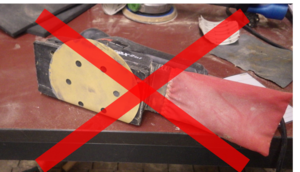Handheld Sander Introduction: Difference between revisions
From CoMakingSpace Wiki
No edit summary |
(Do NOT sand with parts of the velcro pad uncovered...) |
||
| Line 21: | Line 21: | ||
* make sure the tool is turned off before plugging it in | * make sure the tool is turned off before plugging it in | ||
* do not blow the workpiece clean when you're done, best clean it with a moist towel | * do not blow the workpiece clean when you're done, best clean it with a moist towel | ||
== Protect the Velcro == | |||
[[File:wrong sandpaper choice.png|thumb|right|WRONG!]] | |||
Do NOT sand with parts of the velcro pad uncovered - this will wear it out and lead to much poorer bonding of the next piece of sandpaper! | |||
== Suggested Reading == | == Suggested Reading == | ||
Revision as of 17:27, 27 June 2019
This is the content required for an introduction to our handheld sanders - reading this does NOT replace the mandatory session with a tutor! It will make it a lot quicker though ;-)
Let's begin! First off, make sure you have read the machine's manual (should be linked from its wiki page).
Safety
Dangers
- lots of fine dust from wood or plastics - can irritate lungs and skin
- sparks from metal
- powerful movements can make the workpiece shift (or fly!) and let a handheld sander "run away"
- some of the sanders have no prevention of turning on after loss & restoration of power (keine Anlaufsicherung)
Precautions
- wear a dust mask and long clothes if your material generates hazardous dust
- sand outside if you can't connect a shop vac or fine filter
- when sanding metal, do NOT connect dust collection - the sparks could cause a fire!
- wear goggles when working with metal or small workpieces
- ear defenders and gloves are also recommended when working with the sander (and shop vac) for an extended amount of time
- secure your workpiece and exert a firm grip on the tool
- check for a clean run and fit of the sanding medium before you start; check if hole alignment for the dust extraction is correct
- let the tool get to full speed before contacting your workpiece and start with light pressure
- make sure the tool is turned off before plugging it in
- do not blow the workpiece clean when you're done, best clean it with a moist towel
Protect the Velcro
Do NOT sand with parts of the velcro pad uncovered - this will wear it out and lead to much poorer bonding of the next piece of sandpaper!
Suggested Reading
Besides these safety notes, you should read the page about dust to get a better conception of the dangers associated with some materials! Remember, you are responsible for the material you choose and for protecting yourself.
